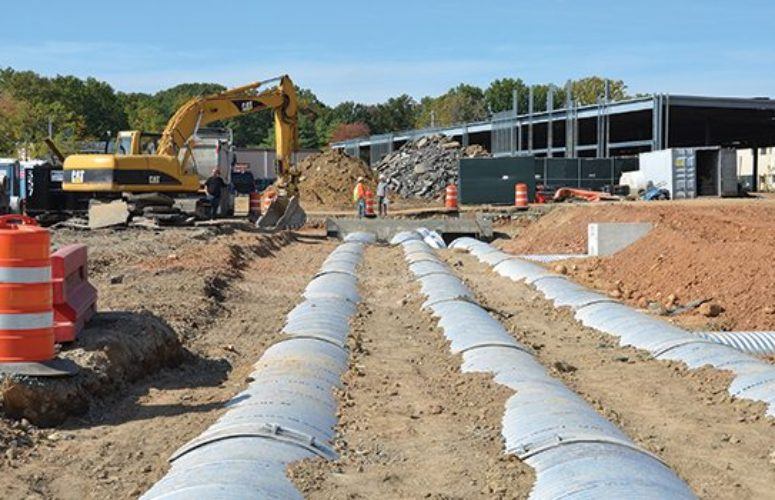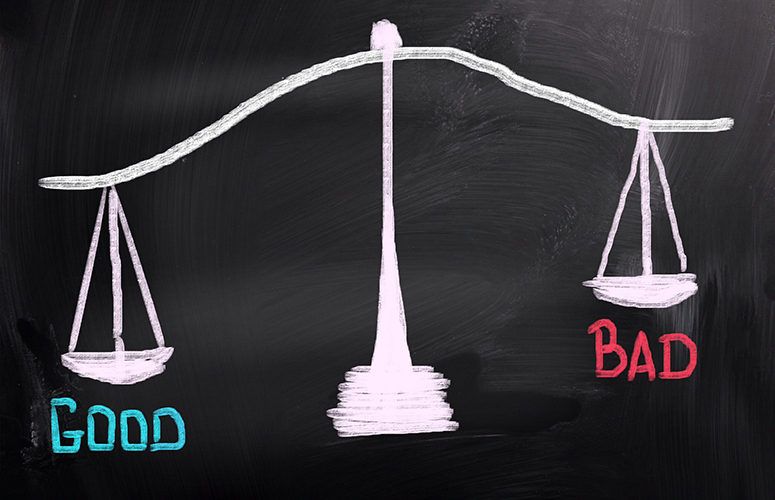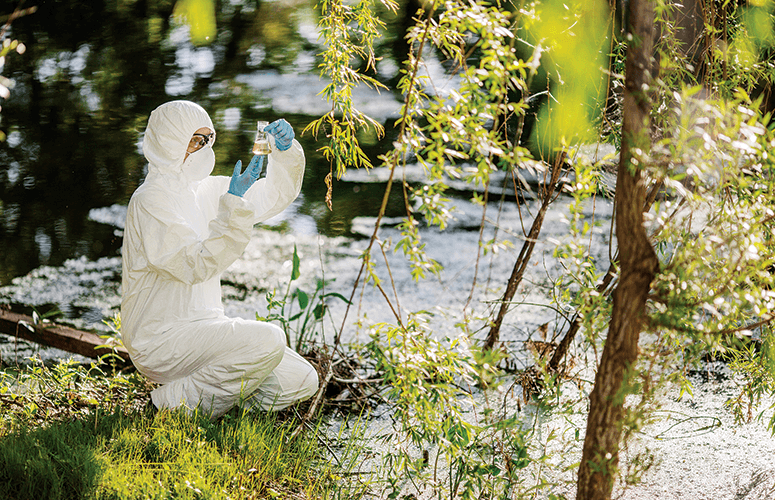
The Licensed Site Remediation Professional Program
More contaminated properties are being cleaned … and faster.
By Lorna Pappas, Contributing Editor On Nov 23, 2015Nearly 13,800 New Jersey property sites are currently being remediated, in various stages, from contamination due to impacted soil, groundwater or vapors as a result of leaking underground storage tanks, chemical spills, improper waste disposal and other environmental mishaps.
Thanks to the state’s Licensed Site Remediation Professional (LSRP) program, those cleanups are happening faster and New Jerseyans’ health and safety are better protected.
When properties are deemed contaminated, parties responsible for cleanup once dreaded the years-long process of the New Jersey Department of Environmental Protection (DEP) pre-approvals and technical red tape. And so did the government: After all, the faster distressed sites are properly cleaned, the sooner they return to the tax rolls, and the faster New Jersey residents and employees are protected from potential environmental harm.
That’s why the state of New Jersey implemented the Site Remediation Reform Act (SRRA), which, in 2009, brought sweeping improvements to the way contaminated sites are remediated. In particular, it mandated that all parties responsible for any existing or newly identified contaminated site complete the remediation of the effected property(s) under specific timeframes and regulations. To achieve this goal, the SRRA established a new class of environmental remediation consultant known as the LSRP, an initiative fully implemented in 2012. The LSRP’s prime directive is to ensure protection of the environment, and the public’s health and safety.
The LSRP helps speed the cleanup process by assuming the NJDEP’s role in overseeing the environmental investigations and remediation of contaminated sites. All accountable parties must initiate and complete cleanups under the direction of an LSRP, who conducts or directly oversees the remediation, and then certifies full compliance with NJDEP statutes and remediation rules.
This article looks at the impact the LSRP program has had on improving contaminated site cleanup in New Jersey. It focuses on several remediation project case studies, and the organizations that support the LSRP mission.
Boswell Shaves Three Project Years
“The LSRP program effectively harnesses the talents of the private sector to help clean the state’s contaminated properties,” explains Stephen Boswell, LSRP and president and CEO of Boswell Engineering, based in South Hackensack. “Previously, the DEP had to review every major step in the process, and though the agency did a fine job, it had limited resources. With private-sector companies now involved in the LSRP initiative, floodgates on those resources are wide open.”
As New Jersey’s environment becomes cleaner, faster, “there’s a definite economic benefit to property owners as well as tax payers,” Boswell continues. “Most noteworthy is that the overall protection of the health and safety of New Jersey’s residents and employees is significantly amplified.”
Boswell points to a specific project – cleanup of the former River Oil Terminal in Passaic – for which the LSRP process will decrease the timeframe of the previous NJDEP review and approval process by about three years.
This facility functioned for more than 60 years, from 1928 until 1993, as a bulk oil and gasoline distribution operation. Petroleum products were stored in numerous above-ground storage tanks (AST) ranging in capacity from 300,000 to 1 million gallons. The site’s new owner retained Boswell to assess the property. More than 20 environmental areas of concern (AOC) were identified, including ASTs, several underground storage tanks, former pump houses, an extensive underground distribution piping network and numerous floor drains, all of which Boswell removed and demolished.
Following a geophysical survey and site investigation, Boswell installed 16 monitoring wells, performed groundwater sampling, designed a petroleum recovery system and prepared the application for the permit required to discharge treated groundwater into the Passaic River.
After the completion of each project phase, comprehensive reports were prepared and signed off by the LSRP, rather than the NJDEP. This reduced the overall project’s time by about three years. Boswell anticipates implementing institutional (deed notice) and engineering (capping) controls to complete the site’s remediation in the near future.
Projects Advance at Maser Consulting
“In our experience, the LSRP program has helped increase project definition; reduce remediation timeframes; and increase predictability for property owners and investors, municipalities and other government agencies,” states Robert Zelley, LSRP, senior principal and director of environmental services for Maser Consulting of Red Bank. “Therefore, some projects that may have remained dormant, perhaps due to unpredictable costs and timing, are now proceeding. The overall objective, always, is the protection of human health and the environment.”
Zelley points to the Tect-Danzig site in Northvale, which was under investigation/remediation since the 1990s, with no advancement in getting the site back to a usable form until an LSRP stepped in. The site was remediated and developed within an impressive one-year timeframe under the LSRP program.
“The LSRP program allowed the quick implementation of remedial action – the capping of impacted soil – which was dovetailed into site redevelopment as a strip mall,” Zelley reports. “Without the LSRP program to streamline the remediation, this site still would be vacant. While final remediation steps are pending, the building and parking lot are now part of the site-wide cap, eliminating exposure to soil and allowing the site use to return to generating jobs and taxes for the borough.”
During the 1990s, Zelley explains, the Borough of Northvale was notified that Tect, Inc. and the Danzig Floor Machine Corporation, both now defunct, buried 55-gallon drums of chemical waste on the property. Additional areas and leaking underground storage tanks were discovered. The findings of Maser Consulting’s investigations, including 122 soil borings and more than 400 soil samples, supported selection of a remedy sustaining the proposed redevelopment. Maser mitigated the highest concentrations of volatile organic compounds (VOCs) using a soil vapor extraction system (SVE). The SVE system along with: the site-wide soil cap; an established deed notice; and enhancing the building design (by installing a vapor barrier under the building slab; and an active, sub-slab depressurization system) will reduce exposure to harmful soil vapors within the proposed building. It also will ensure an environmentally sound restoration and return of this valuable ratable to the borough.
Matrix Quickly Identifies and Mitigates Environmental Issues
Since the effective date of the SRRA, Matrix New World Engineering of Florham Park has assisted its clients with making informed decisions regarding the LSRP program, meeting reporting timeframes, completing remedial action permit applications, and conducting investigations and remediation activities under LSRP guidelines. “Early client discussions are necessary not only to have faster buy-in with the proposed project approach,” reports Edward Sullivan, LSRP and director of LSRP Services for Matrix, “but to clearly define certain LSRP reporting requirements, such as identifying immediate environmental concerns that, under law, must be conducted immediately without prior consultation with the client.”
One such client was a Fortune 500 company planning to occupy a former industrial facility in northern New Jersey. Past operations at the site resulted in the release of various contaminants, including chlorinated solvents such as trichloroethene (TCE). Matrix was retained to provide ongoing environmental services for the investigation and remediation of soil and groundwater. The company evaluated potential soil gas/vapor intrusion issues related to TCE impacts in the groundwater, and then assessed and implemented remedial action.
“A plume of groundwater impacted with TCE had migrated off the property, potentially causing vapor intrusion (VI) issues at an adjacent residential community,” Sullivan reveals. “We implemented a VI study for the community homes, utilizing a phased approach to identify any dwellings within the groundwater plume that may have been impacted.”
Concurrently, Matrix implemented a shallow groundwater investigation and sampling plan to delineate the offsite groundwater contaminant plume. Temporary well points were installed to identify the plume boundaries and facilitate the proper placement of groundwater monitoring wells.
“Our phased approach to the groundwater investigation effort reduced the number of homes requiring VI work by 50 percent,” Sullivan reports. The homes that did contain contaminant levels above the NJDEP Guidance Levels were outfitted with a sub-slab depressurization system. Matrix continues to monitor these homes with annual samplings to ensure that the systems are reducing and controlling the vapor potential into the dwellings.
“When we execute environmental services under the LSRP program, our professional judgment quickly identifies and mitigates environmental issues with minimal NJDEP oversight,” Sullivan adds.
Langan Engineering Contributes to Success of LSRP Program
“For the first time ever, the number of sites cleaned and closed in New Jersey has exceeded the number of cases opened,” states Caryn Barnes, LSRP and principal, vice president of Langan Engineering & Environmental Services, Inc. “Cooperative communications between the state’s LSRPs and the NJDEP has earned solid credibility for both the LSRPs and the program itself.”
Langan has been a contributor to the success of the program since its inception. “We are stakeholders in the vast majority of the NJDEP’s Technical Guidance documents, founding members of the LSRP Association (LSRPA) and provide advocacy on behalf of the responsible parties through the submittal of comments on rules and guidance in conjunction with industry groups,” Barnes says. “We also have an LSRP serving as a member of the Site Remediation Professionals Licensing Board.”
Langan employs 26 LSRPs. All provide expertise on projects with co-mingled and off-site plumes, complex hydrogeology, ecological concerns, VI issues and other challenges. Meeting the regulatory and mandatory timeframes established in the program, Langan’s LSRPs and responsible parties have been highly successful in protecting human health and the environment and expediting cleanups in New Jersey, Barnes reports.
“The state’s LSRP program is still evolving,” Barnes adds. “For example, work needs to be done to improve the timeliness and effectiveness of the permitting process. There are discussions to be had regarding New Jersey’s approach to developing and implementing cleanup standards, to assure they are consistent with the approaches of most other states and the USEPA. We look forward to contributing to these discussions and to the continued success of this evolving process.”
LSRPA Advances the LSRP Profession
LSRPs receive comprehensive support with projects and approaches through the Licensed Site Remediation Professionals Association (LSRPA), a non-profit organization with the goal of advancing the LSRP profession. Membership support includes information, education and technical resources. The LSRPA also promotes the standards of care and use of professional judgment when performing the work of an LSRP in protecting public health, safety and the environment. Currently, the LSRPA consists of 600 members: 431 LSRPs; 152 non-LSRP consultants, professionals, suppliers and lawyers; and 16 students.
“The NJDEP recognizes the LSRPA as the primary group representing LSRPs, which makes us uniquely positioned to advance this profession,” states Mark Fisher, chairman of the association and managing partner of The ELM Group, Inc., an environmental consulting firm headquartered in Princeton. “Our members are valued stakeholders consistently contributing to the ongoing development and improvement to the program. This is accomplished through the dedicated volunteer work of our members on numerous technical and guidance document committees, attendance at LSRP Licensing Board meetings, and quarterly meetings with NJDEP upper management designed to provide direct feedback, enhance communication and address concerns. Additional routine meetings also include NJDEP enforcement and document review staff.”
The LSRPA always looks for opportunities to improve, provide benefits to its members and further advance the profession, Fisher adds. For example, “we currently are beta-testing an on-line sounding board where members can submit questions on difficult or unique issues they encounter, and other members can provide informal feedback. This concept was designed specifically for LSRP members who work at small firms or are solo practitioners where interaction with other LSRPs is a challenge.”
NJBIA Spearheads LSRP Initiatives
The New Jersey Business & Industry Association (NJBIA) works diligently and continuously to support and improve the site remediation process. “We have a diverse membership comprised of companies that are responsible parties, consultants, lawyers, real estate brokers and others,” explains Sara Bluhm, NJBIA’s vice president of environment and energy affairs. “As such, we have a vested interest in the regulatory approach to cleaning contaminated sites here in New Jersey.”
Within the State Legislature, NJBIA has spearheaded the advocacy to change laws related to site remediation, such as one that imposed a remediation investigation deadline on responsible parties. This change helped many companies that were cleaning sites and dealing with the transition over to LSRPs. “Working with other trade associations, we succeeded in having legislation introduced, heard in committee and signed into law in less than six months, which is considered fast in Trenton,” Bluhm reports.
Overall, the Site Remediation Reform Act has been successful in increasing the number of sites being cleaned, she continues. “While there have been some growing pains associated with this change, it has allowed for decisions to be made faster and the environment to be improved more quickly. With several years of experience now under our belts, it’s time to consider enhancements. Several of our members have voiced interest in seeing additional changes made that will help companies and accelerate the cleanup process.”
NJDEP Comments on Program’s Success
According to Mark Pedersen, the NJDEP’s assistant commissioner for site remediation and waste management, “Protecting our communities by cleaning up contaminated sites is a top environmental priority of the Christie Administration. In particular, the Licensed Site Remediation Professional Program, in place since 2009, continues to be extremely successful as a result of the direct oversight of cleanups by LSRPs. This allows the NJDEP to focus even more intently on the most serious of cases that pose potential risk to human health and the environment.”
Related Articles:






